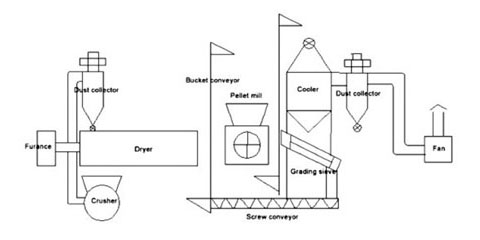What Are Pelletizing Plants?
What is the production process of Pelletizing Plants?
The production process of pelletizing plants can generally be divided into 9 sections, as you can see below.

1. Reduce the size of raw material into appropriate particles.
Among the production process of pelletizing plants, in this section, the raw material needs to be crushed. You can choose the hammer mill, chipper or wood waste shredder in accordance with your raw material.
Based on our comparison tests for different pelletizing plants and common wood & biomass materials, the pellet produced from crushed raw material has better and more consistent quality than those produced from rough raw materials.
2. Dry the size-reduced material to meet required moisture content.
The moisture content of the pellet will straightly affect the pellet quality of the burning efficiency and the clean burning (no smoke).
According to our years of study on pelletizing plants and consultation experiences on pelletizing plant operating, the general requirement to moisture content of wood & biomass materials is from 10% to 15%. By choosing and controlling on right moisture content, you can cut down your cost on energy consumption. In this section, a rotary drum dryer is a good option.
3. Mix the dried material with the binder, lubricants or other needed material.
Due to the different characteristics of various raw materials, the pellet quality is unequal. To improve the pellet quality or maximize the production capacity, you can add a binder (a kind of glue, e.g., vegetable oil or rapeseed cake) during the production process of pelletizing plants to help the lignin-lacked material to compress into pellets much easier. But please test and analyze the binder-added pellets, the ash rate and the clean burning performance may change accordingly.
4. Conditioning process to the mixed material.
By adding dry steam into the mixed material can heat and soften the lignin during the production process of pelletizing plants. This helps the mixed material become compressed into final pellets much easier, and maintains a consistent quality of the mixed material which ensures the consistent quality of pellets. Its final purpose is to increase the pelletizing plants’ production capacity.
Please note: steam conditioning process is ONLY used in some LARGE pelletizing plants, if your mill is a small pelletizing plant, this process is not necessary, you can skip this section.
5. Pellet compression process.
This process usually adopts the ring die pellet machine, also known as round die pellet machine. Actually, this is the most important part in the pelletizing plant.
6. Cool the final pellets to room temperature.
The fresh final pellets extract from the ring die pellet machines are very hot with extra moisture which needs to be released during the production process of pelletizing plant. The unreleased heat and moisture usually makes the pellets soft, so their shape is not formed. To reach the quality requirements on surface hardness and moisture content, the cooling process becomes an important part in the pelletizing plant, and a counter-flow cooler is usually adopted.
7. Screen the cooled pellets.
To remove the fines or dusts from materials that failed in compression process and from some broken pellets, a vibrating screen in the pelletizing plant will be very helpful.
8. Pack and store the screened pellets in pelletizing plant.
Because the biomass pellets will not enter into the fuel process immediately, in order to keep the wood pellets as dry as possible, to avoid the influence from water or dampness, the packing process is necessary. To reduce your cost on labor source, a pellet packing machine is recommended in the pelletizing plant, you can choose a semi-auto or a completely auto one in accordance to your needs.
9. Common transportation machineries in pelletizing plants.
Among the above sections, the materials and the pellets need to be transported between different equipments. To improve the production efficiency, you can use different machines as mentioned below:
Piping system is an infrastructure conveyor corridor in a pelletizing plant site, it is very popular among the above sections, such as between raw material inlet and hammer mills. A considerate design can lower your energy consumption.
The belt conveyor is another common transportation machine. It can be used in for raw material inlet transportation, etc. It is a great solution to reduce your labor cost.
The screw conveyor is another choice for material transportation. Because of its light weight, low cost, and is easy to control.
The bucket elevator is generally used for final pellet transportation in the final stage of pelletizing plant process to prevent damages.
Please note, the sequence of the sections and the choosing of the machines may change in accordance with different material.
